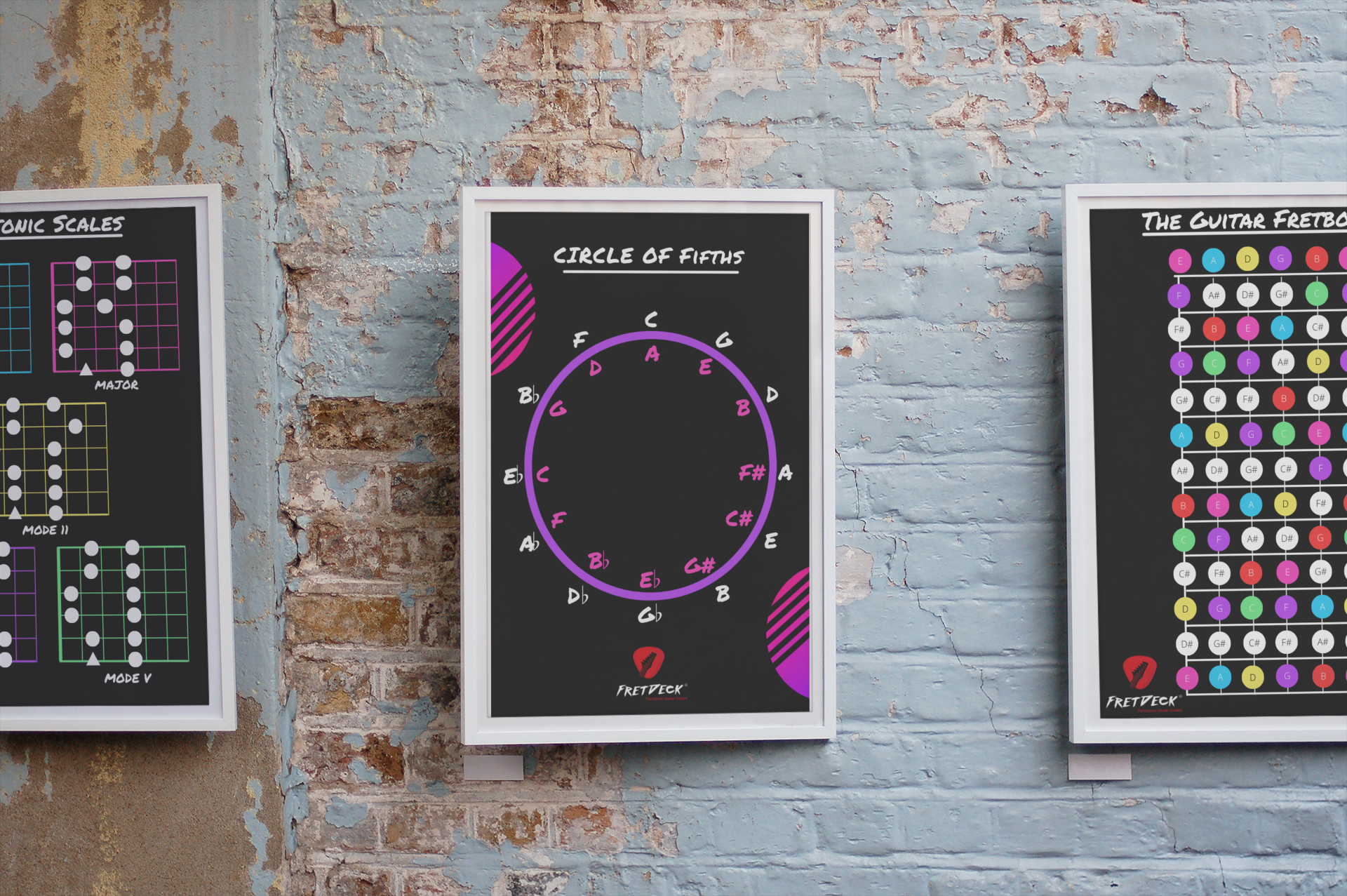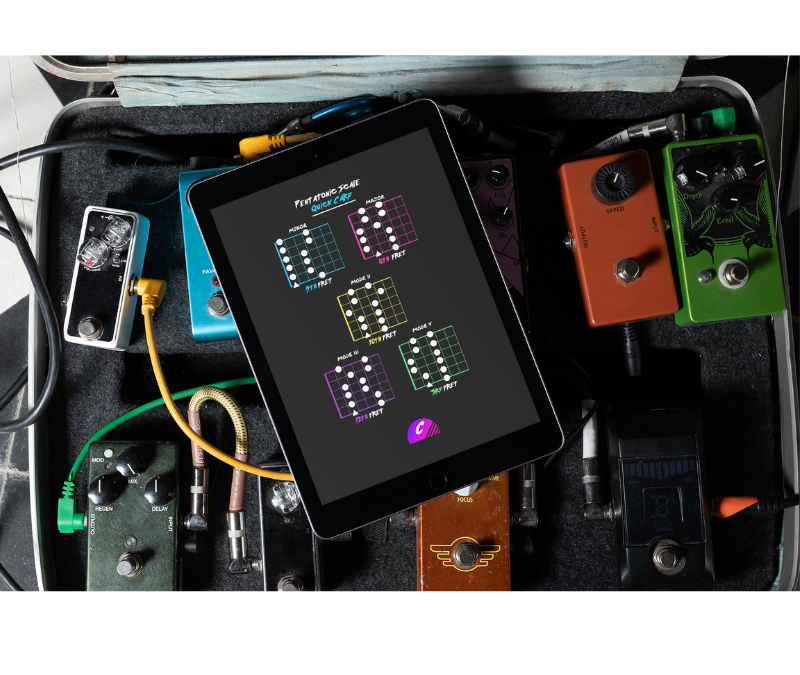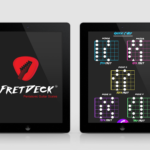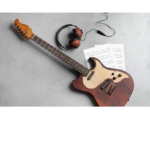The A minor pentatonic guitar scale is a cornerstone of rock, blues, and countless other genres, celebrated for its simplicity and versatility. This five-note scale can be a powerful tool in any guitarist’s arsenal. Whether you’re a beginner or an experienced player, mastering the A minor pentatonic scale can open up new avenues for creativity and expression. Let’s explore eight ways you can use this scale to enhance your playing, focusing on unique riffs, the 5th fret position, and how the FretDeck Pentatonic scales can help you learn all 60 scales in every key.

Download FREE Guitar Charts!
We have 27 FREE guitar charts to help you learn the guitar fretboard. Learn How to play chords and scales with these free resources.
Free Guitar Resources
1. Mastering the 5th Fret Position
One of the most common positions for the A minor pentatonic scale is on the 5th fret. This position is not only easy to remember but also provides a great foundation for exploring the fretboard. Here’s the basic shape:
e|--------------------5-8-|
B|----------------5-8-----|
G|------------5-7---------|
D|--------5-7-------------|
A|----5-7-----------------|
E|-5-8--------------------|
Playing the scale at the 5th fret is perfect for developing muscle memory and understanding the intervals within the scale. Practicing in this position can also help you build speed and precision.
2. Creating Unique Riffs
The A minor pentatonic scale is a goldmine for crafting unique riffs. The simplicity of the scale allows for endless variations and creativity. Here are a few examples to get you started:
Riff 1:
e|--------------------5-------|
B|----------------5h8---5-----|
G|------------5h7---------7-5-|
D|--------5h7-----------------|
A|----5h7---------------------|
E|-5h8------------------------|
This riff uses hammer-ons to add a smooth, flowing feel.
Riff 2:
e|---------------------------|
B|---------------------------|
G|------------5--------------|
D|--------5h7---7p5----------|
A|----5h7-------------7-5----|
E|-5h8---------------------8-|
Incorporating pull-offs and slides can create a more dynamic and expressive sound.
3. Incorporating Bends and Slides
Bends and slides are essential techniques for adding emotion and expression to your playing. In the context of the A minor pentatonic scale, they can make your solos stand out. For example:
Bending Example:
e|---------------------|
B|----8b10r8-----------|
G|------------7-5------|
D|----------------7-5--|
A|---------------------|
E|---------------------|
Here, bending the 8th fret up a whole step adds a bluesy feel to the lick.
4. Combining with the Blues Scale
The A minor pentatonic scale can be easily combined with the blues scale by adding the blue note (Eb/D#). This addition can give your solos a more soulful and gritty edge:
A Minor Blues Scale:
e|--------------------5-8-|
B|----------------5-8-----|
G|------------5-7-8-------|
D|--------5-7-------------|
A|----5-6-7---------------|
E|-5-8--------------------|
Experimenting with this scale can lead to more expressive and varied playing.
5. Using Double Stops
Double stops, or playing two notes simultaneously, can add harmonic richness to your riffs and solos. In the A minor pentatonic scale, try incorporating these intervals for a fuller sound:
Double Stop Example:
e|-------------------|
B|-------5---8---5---|
G|-------5---7---5---|
D|-------------------|
A|-------------------|
E|-------------------|
Using double stops can create a more powerful and resonant tone.
6. Applying the Scale to Chord Progressions
The A minor pentatonic scale fits perfectly over chord progressions in A minor, C major, and other related keys. Here’s a common chord progression in A minor:
Am - C - G - D
Try soloing using the A minor pentatonic scale over this progression. Notice how the notes fit seamlessly over each chord, allowing for smooth and melodic improvisation.
7. Exploring Different Positions on the Fretboard
While the 5th fret position is a great starting point, the A minor pentatonic scale can be played all over the fretboard. Here’s the scale at the 12th fret:
e|--------------------12-15-|
B|----------------12-15-----|
G|------------12-14---------|
D|--------12-14-------------|
A|----12-14-----------------|
E|-12-15--------------------|
Practicing the scale in different positions helps you become more familiar with the entire neck, enabling you to move freely and creatively.
8. Utilizing the FretDeck Pentatonic Scales
To truly master the A minor pentatonic scale and beyond, the FretDeck Pentatonic scales can be an invaluable tool. The FretDeck provides a comprehensive system for learning all 60 scales in every key, making it easier to understand and visualize the fretboard.
Benefits of FretDeck:
- Comprehensive Learning: Learn all pentatonic scales in every key.
- Visual Aids: Diagrams and charts help you see the scales clearly.
- Practice Tools: Exercises and practice routines to reinforce your knowledge.
- Flexibility: Move seamlessly between different scales and keys.
By incorporating the FretDeck Pentatonic scales into your practice routine, you can gain a deeper understanding of the guitar and expand your musical vocabulary.
Conclusion
The A minor pentatonic guitar scale is a versatile and essential tool for any guitarist. Whether you’re playing unique riffs, exploring different fretboard positions, or using the FretDeck Pentatonic scales to learn all 60 scales in every key, this scale can significantly enhance your playing. By mastering the A minor pentatonic scale, you can unlock new levels of creativity and expression in your music. So pick up your guitar, practice these techniques, and discover the endless possibilities that the A minor pentatonic scale offers.

Download FREE Guitar Charts!
We have 27 FREE guitar charts to help you learn the guitar fretboard. Learn How to play chords and scales with these free resources.
Free Guitar Resources










